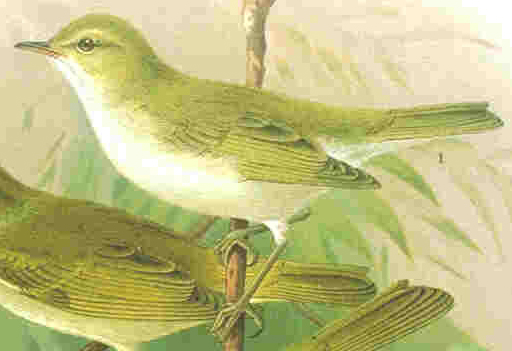- Bonelli's Warbler
Taxobox
name = Bonelli's Warbler

image_width = 240px
regnum =Animal ia
phylum = Chordata
classis = Aves
ordo =Passeriformes
familia =Phylloscopidae
genus =Phylloscopus
subdivision_ranks = Species
subdivision = "Phylloscopus bonelli" "Phylloscopus orientalis"Bonelli's Warbler is a "
warbler " in theleaf warbler genus "Phylloscopus". As a result of modern taxonomic developments, it is now usually considered to be two species (Sangster "et al." 2002, Parkin 2003):
* Western Bonelli's Warbler, "Phylloscopus bonelli", which breeds in south westEurope and northAfrica
* Eastern Bonelli's Warbler, "Phylloscopus orientalis", which breeds in south eastEurope andAsia Minor Their breeding ranges do not overlap; while their appearance and songs are very similar, the calls are completely different (see below). They also show marked difference in
mtDNA sequence (Helbig "et al." 1995).Both species are migratory, wintering in sub-
Sahara nAfrica . They are both rare vagrants in Northern Europe.These small
passerine bird s are found in forest and woodland. 4-6 eggs are laid in a nest on the ground. Like most warblers, Bonelli's is insectivorous.These are small warblers. The adults of both species have a plain grey-green back, green-toned rump and wings and whitish underparts. The bill is small and pointed and the legs brown. The sexes are identical, as with most warblers.
The Western Bonelli's Warbler has a browner tinge to the upperparts than Eastern Bonelli's Warbler; the latter sometimes has a greenish tinge instead. The song of both species is a fast monotone trill, with only slight differences between the two, and also some similarity to
Wood Warbler . The call of the Western Bonelli's Warbler is a disyllabic "hu-it", that of the Eastern a completely different hard "chup", reminiscent of aCrossbill or aHouse Sparrow .(Helb "et al." 1982)This bird is named after the Italian ornithologist
Franco Andrea Bonelli .References
* Helb, H.-W.; Bergmann, H.-H. & Martens, J. (1982): Acoustic differences between populations of western and eastern Bonelli's Warblers ("Phylloscopus bonelli", Sylviidae). "Cellular and Molecular Life Sciences" 38(3): 356–357. (HTML abstract)
* Helbig, A. J.; Seibold, I.; Martens, J. & Wink, M. (1995): Genetic differentiation and phylogenetic relationships of Bonelli's Warbler "Phylloscopus bonelli" and Green Warbler "P. nitidus". "J. Avian Biol." 26: 139–153.
* Parkin, David T. (2003): Birding and DNA: species for the new millennium. "Bird Study" 50(3): 223–242. [http://www.ingentaconnect.com/content/bto/bird/2003/00000050/00000003/art00003 HTML abstract]
* Sangster, George; Knox, Alan G.; Helbig, Andreas J. & Parkin, David T. (2002): Taxonomic recommendations for European birds. "Ibis" 144(1): 153–159. [http://www.blackwell-synergy.com/doi/pdf/10.1046/j.0019-1019.2001.00026.x PDF fulltext]
External links
* [http://www.ibercajalav.net/img/378_BonelliswarblerPbonelli.pdf Ageing and sexing (PDF) by Javier Blasco-Zumeta]
Wikimedia Foundation. 2010.
